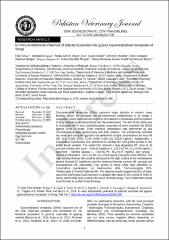| dc.contributor.author | Štrbac, Filip | |
| dc.contributor.author | Krnjajić, Slobodan | |
| dc.contributor.author | Simin, Nataša | |
| dc.contributor.author | Orčić, Dejan | |
| dc.contributor.author | Rinaldi, Laura | |
| dc.contributor.author | Musella, Vincenzo | |
| dc.contributor.author | Castagna, Fabio | |
| dc.contributor.author | Ratajac, Radomir | |
| dc.contributor.author | Stojanović, Dragica | |
| dc.contributor.author | Thagfan, Felwa Abdullah | |
| dc.contributor.author | Khalil, Fatma Mohamed Ameen | |
| dc.contributor.author | Bosco, Antonio | |
| dc.date.accessioned | 2024-12-31T08:06:53Z | |
| dc.date.available | 2024-12-31T08:06:53Z | |
| dc.date.issued | 2024 | |
| dc.identifier.citation | Štrbac F, Krnjajić S, Simin N, Orčić D, Rinaldi L, Musella V, Castagna F, Ratajac R, Stojanović D, Thagfan FA, Khalil FMA and Bosco A, 2024. In vitro anthelmintic potential of selected essential oils against gastrointestinal nematodes of sheep. Pak Vet J. http://dx.doi.org/10.29261/pakvetj/2024.295 | en_US |
| dc.identifier.issn | 0253-8318 | |
| dc.identifier.uri | https://repo.niv.ns.ac.rs/xmlui/handle/123456789/915 | |
| dc.description.abstract | Gastrointestinal nematodes (GINs) represent major obstacle to modern sheep
farming, where the exclusive use of commercial anthelmintics is no longer a
sustainable option due to the development of resistance in nematodes and the problem
of drug residues in animal products and the environment. The aim of this study was
to investigate the in vitro phytotherapeutic properties of seven essential oils (EOs)
against GINs in sheep. Their chemical composition was determined by gas
chromatography-mass spectrometry (GC-MS) analysis. The anthelmintic potential
was evaluated using the egg hatch test performed at eight concentrations for each oil
(50, 12.5, 3.125, 0.781, 0.195, 0.049, 0.025 and 0.0125 mg/mL). Additionally, a
coproculture examination was performed to identify the GIN genera present in the
tested faecal samples. The tested EOs showed a dose-dependent (R2 close to 1)
ovicidal activity with basil - Ocimum basilicum L. (23.3-93.3%, IC50=0.08 mg/mL),
spearmint - Mentha spicata L. (13.0-92.7%, IC50=0.07 mg/mL) and hyssop -
Hyssopus officinalis L. (42.7-91.3%, IC50=0.19 mg/mL) being the most effective. The
high activity of these oils could be attributed to the high content of the monoterpene
alcohol linalool (O. basilicum) and the terpenoid ketones carvone (M. spicata) and
pinocamphone (H. officinalis). Four genera of sheep GINs were identified on
coproculture examination, i.e. Haemonchus 43%, Trichostrongylus 35%,
Teladorsagia 17% and Chabertia 5%. The obtained results suggest that EOs of basil,
spearmint and hyssop could represent a valuable alternative in the control of GINs in
sheep, which could help to reduce the use of chemical drugs. Future field trials should
be performed to confirm these findings. | en_US |
| dc.language.iso | en | en_US |
| dc.source | Pakistan Veterinary Journal | en_US |
| dc.subject | Anthelmintic resistance | en_US |
| dc.subject | Phytotherapy | en_US |
| dc.subject | Integrated parasite control | en_US |
| dc.subject | Egg hatch test | en_US |
| dc.subject | GC-MS | en_US |
| dc.subject | Coproculture | en_US |
| dc.title | In Vitro Anthelmintic Potential of Selected Essential Oils against Gastrointestinal Nematodes of Sheep | en_US |
| dc.type | Article | en_US |
| dc.identifier.doi | 10.29261/pakvetj/2024.295 | |
| dc.citation.rank | M21a | en_US |
| dc.type.version | published | en_US |

